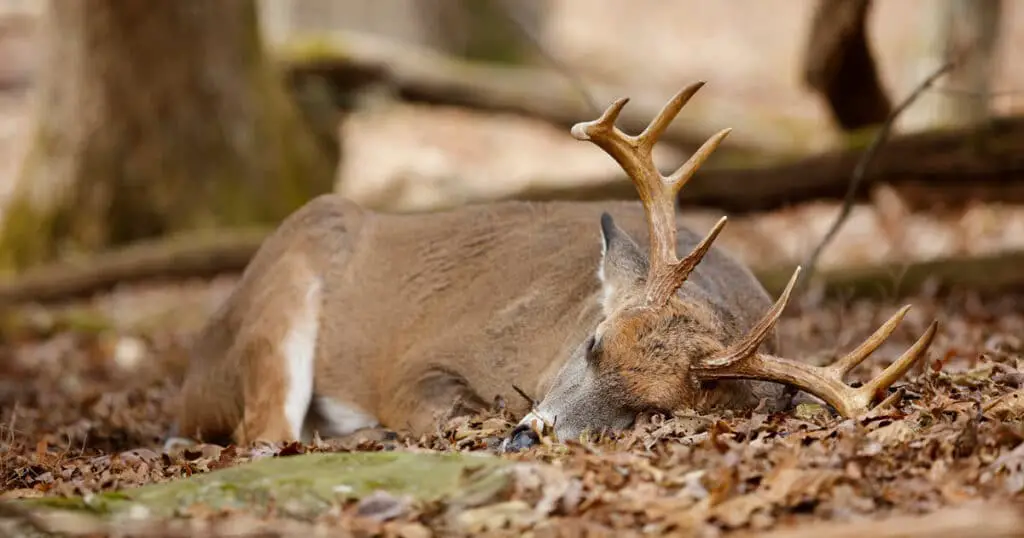With so many predators wanting to eat deer (including venison-loving hunters), you may well wonder how cervids are ever able to get sleep. How can they let their guard down? How do deer sleep without being vulnerable to predation?
Well, the answer is simple: they don’t let their guard down, but they do sleep. Deer stay aware and alert even during this necessary rest.
How Deer Sleep
Most deer sleep in established bedding areas with a lot of cover, so they feel safe. They typically prefer to lie down and curl up while sleeping, but deer have been known to sleep (or at least rest) standing up on occasion. The deer is, of course, a prey animal and must maintain a certain level of awareness at all times to survive. Thus deer rest fitfully for short periods at a time – choosing areas with cover and where the wind will carry the sound and scent of danger approaching.
Do Deer Sleep with their Eyes Open?
Yes, deer may sleep with their eyes open. They can also sleep with their eyes closed. So that the deer can stay aware of any danger in the area, a deer’s eyes will usually stay closed only up to a maximum of five minutes.
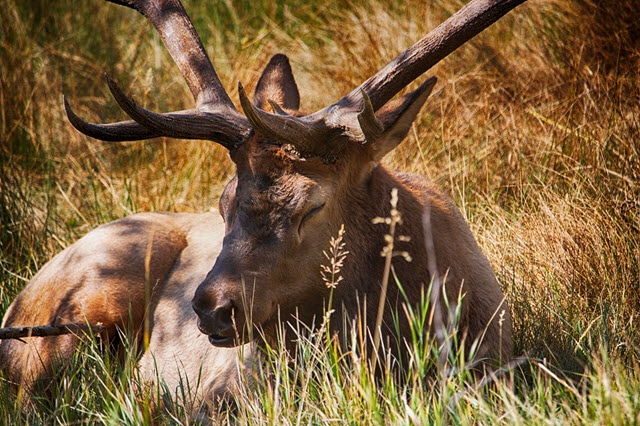
The deer’s ears stay alert throughout the sleep cycle. This means that they will hear any changes in the environment, and the animal can return to alertness and flee immediately.
Do Deer Hear When They’re Sleeping?
Yes, this animal’s ears stay alert at every moment of their sleep cycle. This is why it’s impossible to try to get close to sleeping deer without them detecting you.
Deer have evolved to stay aware of all changes in their environment while they sleep.
Deer also have an acute sense of smell which helps them detect predators during rest. Even when they’re asleep, these cervids will detect the smell of danger in the area.
Do Deer Sleep Standing Up?
Deer usually sleep lying down. They may curl in their limbs as they relax in their bedding area for warmth and a feeling of security. It’s also a way to protect themselves from rain, snow and wind and preserve warmth. It is true, however, that in some cases, a deer may sleep standing up.
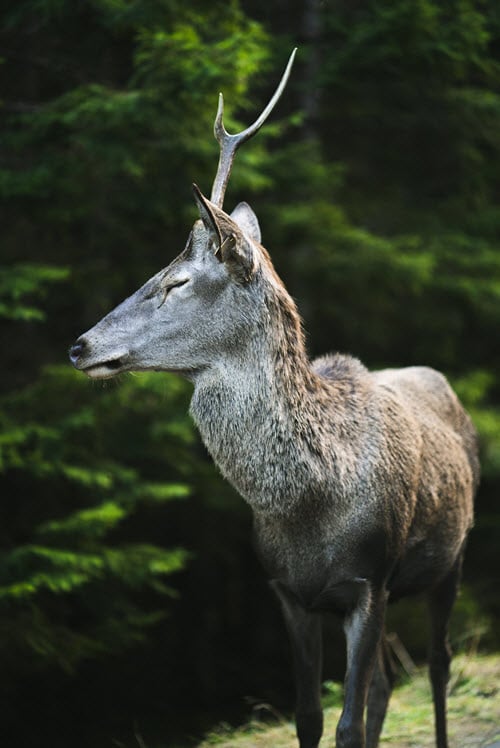
This will usually be in specific settings and situations in which they don’t feel they can safely lie down but they need some sleep.
For example, they may feel there are so many dangers (for example, predators or hunters) in close vicinity that they can’t take the chance of not being able to get up fast enough when threatened.
As deer stay on alert even when lying down and sleeping, and they can get up extremely quickly, this is an unusual circumstance.
Do Deer Lie Down to Sleep?
Yes, deer most often lie down when they want to sleep. They even do so just when they’re relaxing in the bedding area. Most herds will spend the majority of their daylight areas in this safe, familiar area, and they go through numerous sleep cycles in a day.
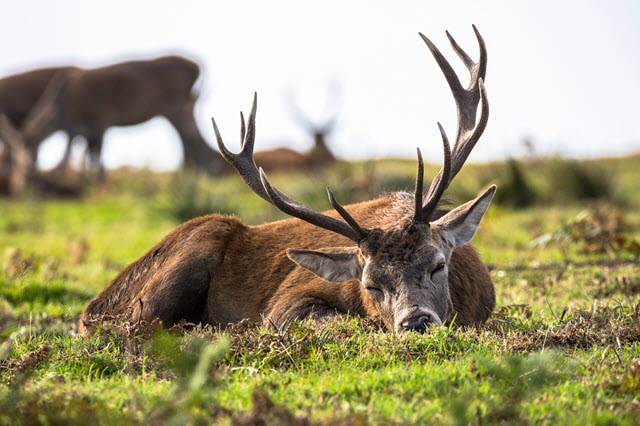
As deer stay alert the whole time they are sleeping, they feel secure in lying down and knowing they can get up and flee quickly if danger approaches.
In unusual circumstances, where a deer feels too nervous to lie down because of dangers close-by, it may rest standing up if it needs to.
While deer sleep, their heads will continue to move. This is necessary to help them hear and smell potential dangers in the area.
Do Deer Sleep Like Humans?
No, deer sleep is very different from how humans rest. Remember, deer are prey animals and they would not be able to survive if they slept the same way we do.
A huge difference between deer and human sleep is how these animals are able to rest with their eyes open. They may also sleep standing up if necessary, and they sleep in extremely short periods.
While humans can rest for hours at a time, deer only rest in micro-periods. These may be as limited as 30 seconds.
Deer and Grooming
A lot of the time they spend in their bedding areas, deer are doing something other than sleeping: grooming.
Grooming is necessary to keep them healthy, it is a way of spending time with their companions, and it helps them relax.
The time deer spend simply sitting and relaxing in their bedding areas is also key to their well-being. It gives their bodies a rest and helps them maintain the strength to survive.
Where Do Deer Sleep?
Deer sleep in their established bedding areas. These animals choose and create their bedding areas based on how much cover is in the area.
They also prefer to relax and sleep in areas that hunters don’t get near.
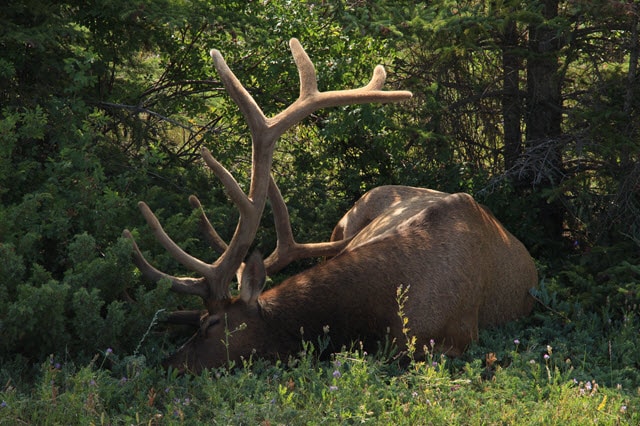
If there is a lot of hunting pressure in the area, deer will be even warier and more cautious than usual, and they will probably go deeper into the forest to make themselves more difficult to find.
Deer will usually venture a minimum of 20 feet through thick foliage to reach a place where predators and hunters will have difficulty finding them.
Do Deer Sleep During the Day or Night?
Most often, deer get their sleep when there is daylight. They tend to sleep the most between noon and 4 o’clock in the afternoon. It’s when the evening and night starts to approach that deer become active.
Deer are crepuscular animals, not nocturnal as many assume. Crepuscular means that they are active during the twilight hours, while nocturnal means that deer are active at night.
Do Deer Ever Sleep at Night?
Deer rarely sleep at night. That is because nighttime is when many of their natural predators are most active.
Even though these cervids are able to stay alert while they sleep, it’s still better to be completely awake and on their feet when they’re being actively hunted.
There are some circumstances in which deer may sleep at night. For example, they may do this if they feel they need to in order to remain hidden or save energy.
Deer are smart enough to do a sort of instinctive “cost-benefit analysis” to determine what it is best for them to do in given circumstances.
How Long do Deer Sleep?
Deer sleep between 30 seconds and three minutes for each short sleep period. Once the deer wakes up and becomes fully aware of its surroundings, to check for danger, it is able to fall back into another of these short periods.
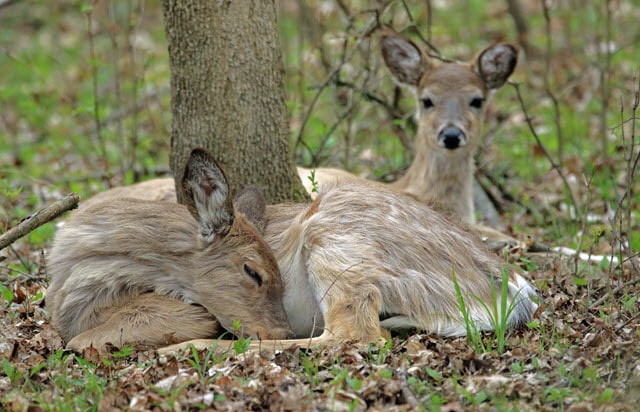
Each cycle of sleeping and dozing has a duration of approximately half an hour.
At the end of each REM cycle, the deer will stand up and move around a little, stretching its muscles and looking around before they get more rest. If they need to, they will also empty their bladders and/or bowels during this time.
A large amount of deer scat is a good way to identify a bedding area of the local herd.
How Often Do Deer Sleep?
When you add up a deer’s total sleep over the course of all its sleep cycles, you see it usually sleeps approximately 12 hours each day. Remember, deer spend most of their time in their bedding areas during the daylight hours.
While deer do have established bedding areas, they have different parts of that area that they will rotate around during the day.
Deer have short sleep cycles of only about 30 minutes, and these include both dozing and deep slumber. To reach about 12 hours, these animals will have numerous sleep cycles each day.
Do Deer Sleep in Groups?
While they may sleep alone occasionally, deer usually sleep in groups. This makes them safer, as several deer are more likely to detect a danger more quickly than one by itself.
Deer usually establish bedding areas that they use for long periods of time. They know where it is and how to get back to their bedding area every time they want to rest.
How Do Deer Sleep in the Rain?
Deer are flexible and tolerant sleepers, and they have no problem sleeping when it’s raining. However, they do like to find sleeping spots with cover from the rain. If it’s windy, they will also look for places that help block the wind.
Deer are especially careful to find safe spots for sleep during rainy weather because of how the rain impedes their senses.
For example, they have difficulty seeing and smelling potential dangers in the area when they’re dealing with rain and wind.
How Do Fawns Sleep?
In the most fundamental ways, fawns (baby deer) sleep in the same way that adult deer do. However, and perhaps counterintuitively, fawns sleep alone for the first part of its life.
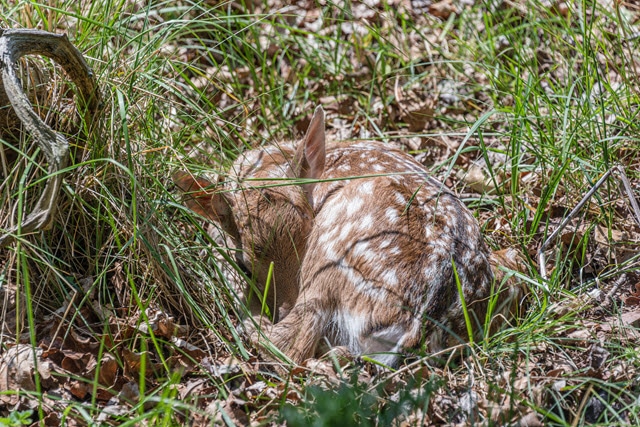
Deer mothers know instinctively that fawns don’t have a scent that will attract predators, and so they are able to keep their babies safer by staying away.
After all, predators can smell the does (female deer), and they would be attracted to the site and find the fawn, which cannot run fast enough to get away.
Of course, the mother visits the fawn on a regular basis for nursing. It takes between two and three months for a fawn to be ready for weaning.
Final Thoughts About How Deer Sleep
As we’ve seen here, deer have developed specific instincts and habits that help them survive while resting. Deer mostly sleep during the day, and they tend to stick to specific bedding areas that are familiar, and where they know that it’s safe to rest.
Deer are able to stay alert, especially when it comes to hearing and the sense of smell, while sleeping.

